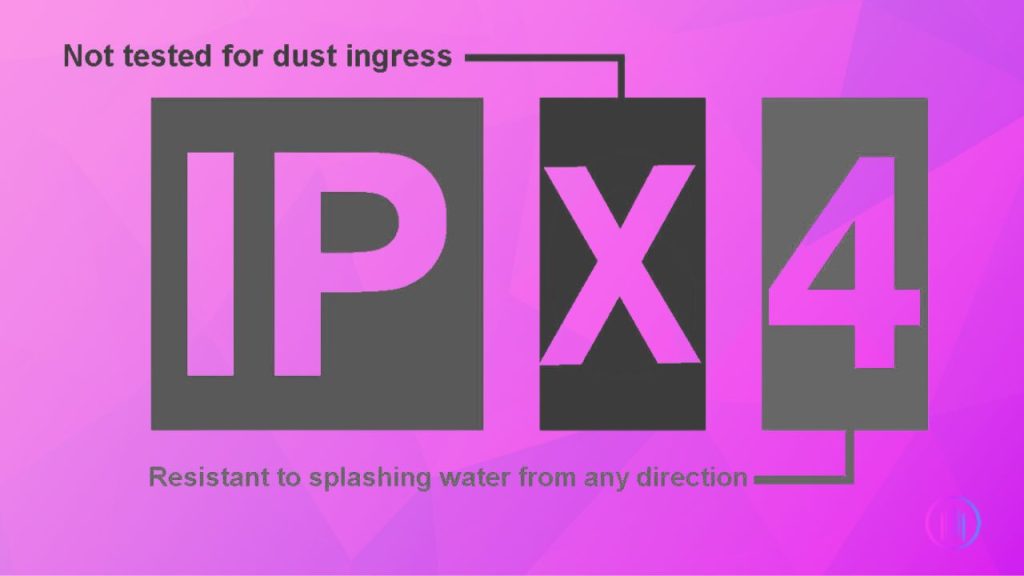Ever paused to think, ‘What exactly is an IPX4 rating, and how does it work to protect my electronic devices?’ This small code, often found etched on our smartphones and speakers, plays a vital role. The IPX4 rating is not just a random combination of letters and numbers; it’s a crucial indicator of how well your device can resist water splashes. In this guide, I’m going to break down what the IPX4 rating really means and how it functions to safeguard your gadgets. We’ll explore the science behind this rating and its practical implications, providing you with a clearer understanding of why it matters in your daily life. So, as we venture into the world of IPX4, prepare to gain insights that will change how you view the resilience of your everyday electronics.
Notable Points
- IP rating is a global standard for indicating the level of protection electronic devices have against dust and water.
- IPX4 rating is a specific part of the IP rating system, showing a device’s resistance to water splashes from all directions.
- IPX4 rating means a device can handle water splashes from any angle, with ‘X’ indicating dust protection is not specified.
- IPX4 provides a higher level of water splash protection compared to lower IPX ratings.
- Devices with an IPX4 rating are rigorously tested to ensure they can withstand water splashes from all directions.
- IPX4 is suitable for situations with risk of water splashes; higher ratings are needed for more intense water exposure.
- IPX4 is ideal for devices used in conditions where they might be exposed to light rain or splashes, offering reliability in slightly wet environments.
What is an IP Rating?
The International Electrotechnical Commission (IEC) has established a detailed standard, defining varying levels of protection against dust and water ingress for electronic devices. This standard is complemented by the International Organization for Standardization (ISO) with some variations.
Dust Ingress Protection:
The IEC standard specifies seven levels of dust ingress protection. The first numeral in the IP rating, ranging from 0 to 6, indicates the level of dust protection. A rating of ‘0’ suggests no protection against dust ingress, practically implying the presence of openings larger than 50mm. On the other end, a ‘6’ signifies that a device is completely dustproof, offering the highest level of protection.
Water Ingress Protection:
Similarly, for water ingress, the IEC standard outlines ten levels of protection. The second numeral in the IP rating, which can be between 0 and 9, describes this. A ‘0’ here means no protection against water, whereas a ‘9’ indicates the device’s ability to withstand high-temperature and high pressure water jets. Notably, devices with ratings of ‘7’ and ‘8’ are often referred to as waterproof, as they are capable of surviving temporary (IPX7) or continuous (IPX8) submersion in water.
The Use of ‘X’ in IP Ratings:
In instances where a device has not been tested for either dust or water ingress, an ‘X’ replaces the respective numeral. For example, ‘IPX4’ would mean the device’s water resistance has been tested (to the level of withstanding splashes from any direction), but its dust resistance has not been evaluated.
Divergence in ISO and IEC Standards:
While the IEC standard forms the basis, the ISO standard (ISO 20653) introduces some variations. Specifically, it includes three additional ratings: IPX4K, IPX6K, and IPX9K. The ‘K’ suffix denotes increased pressure. It’s interesting to note that while the IEC standard does not use ‘K’ ratings, its IPX9 is analogous to ISO’s IPX9K. Consequently, the only ISO ratings not recognized by the IEC standard are IPX4K and IPX6K.

What is the IPX4 Rating?
The IPX4 rating is an important part of the International Protection (IP) Code. This code is a global standard, set by the International Electrotechnical Commission (IEC) in 1976 and later expanded by the International Organization for Standardization (ISO). It’s used to measure how well electronic devices are protected against different types of intrusion, like dust and water. Specifically, the IPX4 rating focuses on a device’s resistance to water. It tells us that a device with this rating can handle water splashes from any direction. This is crucial information for users who want to ensure their gadgets can withstand certain water-related conditions. Knowing about the IPX4 rating helps in making informed decisions when buying electronics, especially if you plan to use them outdoors or near water.

Understanding the IPX4 Rating
| Feature | Description |
|---|---|
| IPX4 Rating | Splash Protection |
| Dust Protection | Not Specified (Indicated by ‘X’) |
| Water Protection | Protection against water splashes from any direction |
| Practical Scenario | Suitable for use in light rain, during workouts, or in situations where the device might be splashed with water |
| Compared to Other Ratings | Higher water resistance than IPX0-IPX3, but not designed for submersion like IPX7 or IPX8 |
| Applicable Standards | Part of the IEC (International Electrotechnical Commission) standard, recognized globally |
1. The Essence of IPX4:
IPX4 is a crucial rating in the tech world, showing how well a device can handle water splashes from all directions. This rating is especially important for anyone who uses their gadgets outdoors or during physical activities where they might get wet. The ‘IPX4’ mark means two things: the ‘X’ tells us that the device hasn’t been tested for dust resistance, and the ‘4’ confirms its ability to resist water splashes. This protection is more advanced than the first three IPX levels, which only protect against water hitting the device at specific angles. With IPX4, you’re getting a higher level of assurance that your device can withstand splashes, no matter where they come from. This makes IPX4 rated devices a smart choice for those who lead active lifestyles or simply want extra peace of mind in everyday situations where water might be a concern.
2. Testing and Standards:
When you come across a gadget with an IPX4 rating, it’s not just a technical label, it’s a mark of reliable testing and everyday practicality. These devices are meticulously tested with water sprays from every direction, a process that’s quite revealing about their durability. It’s not just about surviving a splash it’s about ensuring consistent performance even when life gets a bit wet. This robust testing makes an IPX4 rated device stand out from those with lower ratings. For you as a consumer, this means a gadget that’s more than capable of handling typical water encounters be it a sudden drizzle or an accidental spill. It’s this assurance of everyday resilience that makes IPX4 rated devices a practical choice in our daily lives.
Testing Equipment for IPX4 Certification:
When it comes to certifying electronic devices with the IPX4 rating, specialized testing equipment is crucial. These tools are designed to rigorously challenge the device’s ability to withstand water splashes from every direction.
- Spray Nozzle Method: In this approach, devices undergo a thorough examination using a spray nozzle. This nozzle emits water at a controlled flow rate of 10 liters per minute. The water pressure is meticulously maintained between 80 and 100 kilopascals to mimic real-life splash conditions. During the test, the device is methodically sprayed from various angles to ensure all-around protection. The duration of this test is a minimum of 5 minutes, which is essential to guarantee consistent performance under wet conditions.
- Oscillating Tube Technique: Another effective method employs an oscillating tube. This tube, equipped with multiple holes, showers the device with water at a rate of 0.07 liters per minute from each hole. To simulate splashes coming from all directions, the tube rotates 360 degrees around the device. The testing period using this technique extends to 10 minutes. This extended duration is pivotal in assessing the device’s resilience to prolonged exposure to water splashes.
3. Choosing the Right IPX Rating:
Choosing the right IPX rating for your devices is essential to ensure they suit your daily activities and specific environments. An IPX4 rating is sufficient for regular use, safeguarding against splashes from any direction, making it suitable for light rain or shower use. However, this rating isn’t designed for submerging devices in water. Based on my personal experience, for those who often engage in activities like swimming, boating, or are exposed to heavy rain, a higher IPX rating is highly recommended. Devices with IPX7 or IPX8 ratings are more robust, capable of withstanding temporary or even continuous immersion in water. This enhanced protection keeps your device safe and operational in more extreme conditions. By selecting the appropriate IPX rating, you not only prolong the life of your device but also gain confidence in its reliability, no matter where your adventures take you.
4. Practical Implications of IPX4:
Understanding the practical implications of an IPX4 rating is vital when selecting electronic devices. This rating, especially relevant for smartphones, earbuds, and portable speakers, signifies their ability to withstand water splashes. Such durability is not just a theoretical advantage but a practical one, as evidenced in everyday scenarios. For instance, using IPX4 rated earbuds during vigorous workouts ensures they remain unaffected by sweat, and carrying an IPX4 rated smartphone during a light rain offers peace of mind. The assurance that these devices can handle occasional splashes enhances their usability in outdoor and fitness settings. This resilience against moisture is particularly valuable for those leading an active lifestyle or for anyone who wants dependable electronics in potentially wet conditions. Therefore, opting for products with an IPX4 rating is a wise choice, ensuring your devices stay functional and reliable, even amidst accidental water encounters.
Final Thoughts
Understanding the IPX4 rating helps us choose the right gadgets for our needs, especially when it comes to protecting them from water splashes. This rating, crucial for devices like smartphones, earbuds, and speakers, ensures they can handle everyday challenges like a sudden rain or a workout session. It’s important to remember, though, for activities involving more water exposure, opting for a higher IP rating might be better. As we continue to rely more on technology in our daily lives, being informed about these ratings is key to picking durable and reliable devices. May your tech choices bring you both convenience and confidence in all your adventures!
FAQs
Yes, gadgets with an IPX4 rating are water-resistant. They are designed to withstand splashes of water from any direction, ensuring protection in scenarios like light rain or accidental liquid spills. However, it’s important to note that while IPX4-rated devices resist water splashes, they are not suitable for full immersion in water.
Gadgets with an IPX4 rating are versatile and suitable for both outdoor and indoor use. Their ability to withstand water splashes makes them ideal for outdoor activities like jogging in light rain or poolside use. Similarly, they offer reliable performance indoors, especially in environments where they might be exposed to accidental splashes, like in kitchens or bathrooms. This makes IPX4-rated gadgets a robust choice for various settings and lifestyles.
Yes, IPX4 and IP54 both protect against water splashes from any direction. The difference is in dust protection. IP54 means the device is also protected against dust. In IPX4, the ‘X’ means we don’t know how much dust it can handle. So, they are the same for water, but not for dust.

I’m Shaun Conroy, an audiophile & founder of HiFi Audios. Holding a Bachelor’s in Sound Engineering, I bring deep expertise in audio devices and offer insights & recommendations to fellow enthusiasts.





